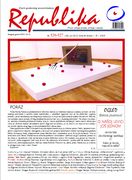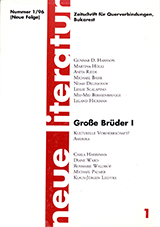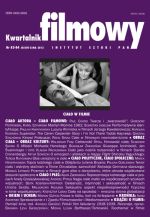Ekskrementima daha do nepredstavljivog
Na koji se način u međusoban odnos mogu dovesti tekst kao anagram tijela (Barthes) i dah kao nevidljivo pismo tijela kojime se ono raspoređuje unutar teksta?
More...We kindly inform you that, as long as the subject affiliation of our 300.000+ articles is in progress, you might get unsufficient or no results on your third level or second level search. In this case, please broaden your search criteria.
Na koji se način u međusoban odnos mogu dovesti tekst kao anagram tijela (Barthes) i dah kao nevidljivo pismo tijela kojime se ono raspoređuje unutar teksta?
More...
»Glumac je stranac na svojoj zemlji«, zapisuje Zuppa (1989: 22) u knjizi Uvod u fenomenologiju suvremenog hrvatskog glumišta ili štap i šešir. I sama »institucija kazališta, kao subjekt«, nastavlja Zuppa (1989: 35), »priklanja se nenormalnome. « Možda čak neznanome ili bezdomnome, ako domovinsko glumište definiramo kao mjesto unaprijed uspostavljenih hijerarhija i naslijeđenih pravila igre. Branko Gavella također je jedan od stranaca domaćeg glumišta. Ne samo zbog brojnih izvandomovinskih lokacija na kojima je boravio, nego i zbog odluke da za sebe kaže kako je prvenstveno »kritičar«, pa tek onda redatelj. I ta relacija obvezuje, zato što je u Hrvatskoj permanentni skandal odrediti se kritičkom vokacijom.
More...
Antonin Artaud je u dvije svoje nadrealističke drame umetnuo prizor u kojem ljudski udovi padaju na pozornicu. Početak Le Jet de sang (Mlaz krvi, 1925) prikazuje dvoje mladih koji patetično izjavljuju ljubav jedno drugome, kada iznenada počne bjesnjeti orkan, dvije se zvijezde sudare i »niz nogu otkinutih sa živih tijela padaju, zajedno sa stopalima, rukama, glavama, maskama, kolonadama, portalima, hramovima i laboratorijskim posudama«1 (Artaud, 1976a, 71). U kasnijem scenariju pripremljenom za projekt kazališta okrutnosti La Conquête du Mexique (Osvajanje Meksika, 1933) kiša ljudskih udova odjekuje gotovo doslovno.
More...
Antonin Artaud — tko je to? Ime, znak ili događaj? Imenovanje je znak sudbine: nomen est omen. Znak najradikalnijega obrata umjetnosti i života u razdoblju povijesne avangarde 20. stoljeća zacijelo je Artaudov projekt prevladavanja reprezentacijskoga kazališta jezika i govora. Povratak fizičkoj ekspresiji tijela čini se da je alternativa vladavini psihološke drame subjekta. Kada se znak znamenuje događajem insceniranja umjetnosti kao života, tada se istodobno radikalno mijenja perspektiva ne samo umjetnosti nego ponajprije onog što se razumije životom.
More...
Jezik postaje u javnom smislu posve sporna stvar. Jezik se ispričava zbog jezika, postaje sumnjiva roba, problematičan kao {to jest i uvijek pod kontrolom onog što Zuppa zove naprimjer »lingvistički imperijalizam«.
More...
“În anii `60-`70, umanitatea era fascinată de explorarea spaţiului, contemplînd primii paşi ai omului pe Lună, şi urmărea experienţele psihedelice conduse de personalităţi ca Timothy Leary, Aldous Huxley sau Allen Ginsberg, care pătrundeau în profunzimile abisale ale spaţiului interior. Astăzi, în contextul proliferării Internet-ului […]”
More...
Caragiale's literary works various areas, but each shape stronger, more surprising portrait of the author. Be it short prose, short stories, drama or literature epistolary writings, Caragiale proves to be a lucid and sarcastic observer of people, sometimes more or less willingly, sensitive or prone to psyhologising.
More...
I. L. Caragiale was a fine observer of his time, taking his subjects from society, satirizing in a bitter but at the same time ”juicy” language. Eugène Ionesco has been influenced in his creation by many authors, the most noticeable relations being established with Caragiale’s work, by whoom he was fascinated. The bonds between the two are numerous and much of Ionescu’s work can be re-read from the perspective of an intertextual dialog with Caragiale’s work. Both dramatists have been concerned with the role of writing in the theatrical act, contributing to its the renewal. I. L. Caragiale has also turned out to be a theoretician, who recommended a well organised manner of theatrical conception. Caragiale’s characters, especially the ones passionate about politics, reflect an obvious ”psychical absenteeism” being bared of even of an authentic inner life, for example - Cațavencu. The demagogy and the absurd in the political speeches will be transcribed in time by Eugène Ionesco in the ”caragialisms” of Ma’am Pipe (Mère Pipe) from Hit Man, a mixture of ”caţavenci, ioneşti, popeşti or farfurizi”.
More...
art of acting, female character, Caragiale
More...
The offer of the multiple possibilities of staging the work of Caragiale is a starting point for studies and workshop shows carried out in the space of higher education in theatre. The dramatic show approached from the perspective of direction or the study of the actor’s art is just the classic option; however, cartoon theatre is an equally challenging option. The proximity to the universe of Caragiale can be explained by the avant-garde vein and the architectural construction of his writings; the imagery created stirs imagination, the acidity of parallels with human torts (which are universal and atemporal), the structures which are considered to be classic to new approaches.
More...
Starting from the idea of creating a puppetry show using a dramatic text written by I.L. Caragiale, we are presenting in this article some stages of the transformation of a virtual project published in our doctoral thesis, in a show, giving arguments for the puppetry characteristics of the dramatic text. We are talking about our own way of acting the comedy A Lost Letter with puppets. The event is now unique on the Romanian stages and it equally marks the performance for the bachelor degree of the 2011 graduate class from the ”George Enescu” University of Arts. Our performance was very well received at the International Festival of Acting Schools CLASSFEST from Chisinău, in the Republic of Moldavia, which made it possible to be selected to participate to the International Festival of Acting and Movie Hyperion, 10th edition, Bucharest, where it won the Special Prize of the Jury.
More...
Regarding Caragiale, exegesis is very rich. Well known from studies that G. Ibrăileanu, G. Calinescu, I. Cazaban, Şt. Casimir, Maria Voda Capusan books by lesser known or not so famous authors names, the list is very long. Petra Petrescu's work dedicated to Romanian playwright, with good deck and statements that could be reviewed, it is noted in Romanian exegetical landscape.
More...
The “Caragiale” phenomenon in the theatrical practice of the past few years is certainly worth analyzing rigorously. If we take into account that no less than eighty-four performances have been staged in the country on the most important dramatic stages as well as in alternative theatres and companies for the past ten years, the premises seem definitely promising. We would be tempted to see in the multitude of shapes taken by Caragiale’s work in the limelight precisely its stimulating depth. This generates our question – how efficient, how healthy is the perpetual reformulation, how favourable is the permanent search for the new and how favourable is the process of updating the plays in the context of the modern myths of the years two thousand?
More...
As it is well known, at the end of 1904, Caragiale settled permanently in Berlin, in his self-exile deriving from his discontents in his country. This decision was possible due to a substantial inheritance from his rich relative, Momuloaia, which spared him from financial worries.
More...
The author deals with the messianic traits of a hero who is a protagonist of contemporary mainstream film. Basic assumption of this paper is observation that despite the so-called “end of grand narratives” proclaimed by postmodern philosophers at the end of the last century, there are phenonema in culture clearly contradicting former predictions: renaissance of a novel, rising popularity of historical and fantastic stories and new heroes with complex character and genuine humanistic qualities. According to the author this proves the fact that human need for transpersonal values, moral patterns and stories carrying the message of meaningfulness of human destiny, is historically stable. The paper examines various representations of film hero within the broader context of social meanings in cinema (social dimension of film). The author describes psychoanalytic and anthropological concepts of hero as well as Jesus Christ as an archetype of Savior. Some of his special traits serve as a model for conceptualization of messianic hero and his basic characteristics. The text provides numerous examples of strong and weak heroes who alternately resurfaced the mainstream film through the decades. The author believes that the former narcissistic action hero and insecure hero is being replaced with more authentic and vibrant hero: a character who is vulnerable and commited to sacrifice in favor of others at the same time.
More...

The subject of the article are the changes in the complex relationship between body and identity in the work of David Cronenberg over the last 25 years that passed since he entered mainstream cinema. Using the example of "Scanners", the first film that put the question of identity center-stage, bodily basis of identity typical for the early work of the director is described, as well as the consequences of the blurring of bodily boundaries for the way protagonists perceive their own “I”. "The Dead Zone" and the "Spider" show a gradual shift in the director’s interest, from issues related to the spacial boundaries of the body to the question about the continuity of identity in time and the problem of the body as a carrier of information. These problems are further explored in the two later films of the director: "A History of violence" and "Eastern Promises", which testify to the director’s changing perspective on the question of the body and identity; it is at the same time a change of perspective from an individual to sociopolitical one.
More...
It is not the first time that Michael Haneke challenges his audience. How are we to understand what the film shows and reveals? What is the meaning of the film’s story? The author of the article tries to pin point the performative nature of the film and the importance of corporeality in the presentation and telling of this story. He claims that the action (performance) is more important than words in the film, which is why this film can have a very strong impact on the viewer. The “performativity” of the film forces onto the viewer a different kind of reflection, one far exceeding easy expressed meaning. The director puts forward very strongly the issue of self determination, the possibility of deciding one’s own fate, even when it is no longer an easy matter to take that fate into one’s own hands. He presents a situation, a “place” where the individual loses out to the organised raison of “society”, which supports “life”. The article also raises the question of the adequacy of the film title. The author comes to the conclusion that Gabriel Marcel’s opinion that to love means to tell the other person: “you are never going to die”, paradoxically, is highly adequate in relation to this film.
More...
In modern humanities understanding of the body as a substance or being gradually gives way to interest in processes, sensations and affects that pass through and between bodies. The emphasis on intangible and unconscious flows poses a particular kind of challenge to a film analyst, as these are the dimensions of human experience that to a large extent are not subject to verbalisation or visualisation. Szarecki proposes to consider body as a medium between the representation and the materiality of the image, taking into the account both politics of meanings focusing on the representations of the body in film, and the politics of experience associated with the creation of affective relationships. The author demonstrates this approach using the example of the Japanese film "Happy flight" by Shinobu Yaguchi, arguing that although the body images presented in the film bypass the dynamics and movement of affective flows, these might manifest themselves in sensory responses to the developing action and the accompanying changes in sounds and images.
More...